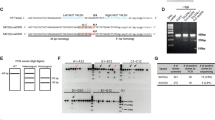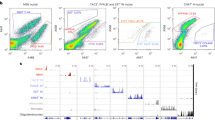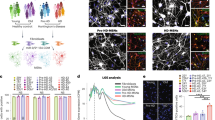Abstract
Huntington disease (HD) is a genetically dominant condition caused by expanded CAG repeats coding for glutamine in the HD gene product huntingtin1. Although HD symptoms reflect preferential neuronal death in specific brain regions, huntingtin is expressed in almost all tissues2, so abnormalities outside the brain might be expected. Although involvement of nuclei3,4,5,6,7 and mitochondria8,9,10,11,12,13,14 in HD pathophysiology has been suggested, specific intracellular defects that might elicit cell death have been unclear. Mitochondria dysfunction is reported in HD brains10,11,12,13; mitochondria are organelles that regulates apoptotic cell death15,16. We now report that lymphoblasts derived from HD patients showed increased stress-induced apoptotic cell death associated with caspase-3 activation. When subjected to stress, HD lymphoblasts also manifested a considerable increase in mitochondrial depolarization correlated with increased glutamine repeats.
This is a preview of subscription content, access via your institution
Access options
Subscribe to this journal
Receive 12 print issues and online access
$209.00 per year
only $17.42 per issue
Buy this article
- Purchase on Springer Link
- Instant access to full article PDF
Prices may be subject to local taxes which are calculated during checkout



Similar content being viewed by others

References
MacDonald, M.E. & Gusella, J.F. Huntington's disease: translating a CAG repeat into a pathogenic mechanism. Curr. Opin. Neurobiol. 6, 638–43 (1996).
Li, S.H. et al. Huntington's disease gene (IT15) is widely expressed in human and rat tissues. Neuron 11, 985– 993 (1993).
Klement, I.A. et al. Ataxin-1 nuclear localization and aggregation: role in polyglutamine-induced disease in SCA1 transgenic mice. Cell 95, 41–53 (1998).
Saudou, F., Finkbeiner, S., Devys, D. & Greenberg, M.E. Huntingtin acts in the nucleus to induce apoptosis but death does not correlate with the formation of intranuclear inclusions. Cell 95, 55–66 (1998).
Davies, S.W. et al. Formation of neuronal intranuclear inclusions underlies the neurological dysfunction in mice transgenic for the HD mutation. Cell 90, 537–548 ( 1997).
DiFiglia, M. et al. Aggregation of huntingtin in neuronal intranuclear inclusions and dystrophic neurites in brain. Science 277, 1990–1993 (1997).
Becher, M.W. et al. Intranuclear neuronal inclusions in Huntington's disease and dentatorubral and pallidoluysian atrophy: correlation between the density of inclusions and IT15 CAG triplet repeat length. Neurobiol. Dis. 4, 387–397 ( 1998).
Schapira, A. H. Mitochondrial function in Huntington's disease: clues for pathogenesis and prospects for treatment. Ann. Neurol. 41, 141–142 (1997).
Beal, M.F. et al. Neurochemical and histologic characterization of striatal excitotoxic lesions produced by the mitochondrial toxin 3-nitropropionic acid. J. Neurosci. 13, 4181– 4192 (1993).
Gu, M. et al. Mitochondrial defect in Huntington's disease caudate nucleus. Ann. Neurol. 39, 385–389 (1996).
Koroshetz, W.J., Jenkins, B.G., Rosen, B.R. & Beal, M.F. Energy metabolism defects in Huntington's disease and effects of coenzyme Q10. Ann. Neurol. 41, 160– 165 (1997).
Browne, S.E. et al. Oxidative damage and metabolic dysfunction in Huntington's disease: selective vulnerability of the basal ganglia. Ann. Neurol. 41, 646–653 ( 1997).
Tabrizi, S.J. et al. Biochemical abnormalities and excitotoxicity in Huntington's disease brain. Ann. Neurol. 45, 25– 32 (1999).
Arenas, J. et al. Complex I defect in muscle from patients with Huntington's disease. Ann. Neurol. 43, 397– 400 (1998).
Green, D.R. & Reed, J.C. Mitochondria and apoptosis. Science 281, 1309–1312 ( 1998).
Kroemer, G., Dallaporta, B. & Resche-Rigon, M. The mitochondrial death/life regulator in apoptosis and necrosis. Annu. Rev. Physiol. 60, 619 –642 (1998).
Zamzami, N. et al. Reduction in mitochondrial potential constitutes an early irreversible step of programmed lymphocyte death in vivo. J. Exp. Med. 181, 1661–1672 ( 1995).
Ankarcrona, M. et al. Glutamate-induced neuronal death: a succession of necrosis or apoptosis depending on mitochondrial function. Neuron 15, 961–973 (1995).
Servadio, A. et al. Expression analysis of the ataxin-1 protein in tissues from normal and spinocerebellar ataxia type1 individuals. Nature Genet. 10, 94–98 ( 1995).
Marchetti, P. et al. Mitochondrial permeability transition is a central coordinating event of apoptosis. J. Exp. Med. 184, 1155 –1160 (1996).
Nicolli, A., Basso, E., Petronilli, V., Wenger, R.M. & Bernardi, P. Interactions of cyclophilin with the mitochondrial inner membrane and regulation of the permeability transition pore, and cyclosporin A-sensitive channel. J. Biol. Chem. 271, 2185–2192 (1996).
Snyder, S.H. & Sabatini, D.M. Immunophilins and the nervous system. Nature Med. 1, 32– 37 (1995).
Anholt, R.R., Pedersen, P.L., De Souza, E.B. & Snyder, S.H. The peripheral-type benzodiazepine receptor. Localization to the mitochondrial outer membrane. J. Biol. Chem. 261, 576– 583 (1986).
Yang, J. et al. Prevention of apoptosis by Bcl-2: release of cytochrome c from mitochondria blocked. Science 275, 1129– 1132 (1997).
Jacobsen, M.D., Weil, M. & Raff, M.C. Role of Ced-3/ICE-family proteases in staurosporine-induced programmed cell death. J. Cell Biol. 133, 1041–1051 (1996).
Kuida, K. et al. Reduced apoptosis and cytochrome c-mediated caspase activation in mice lacking caspase 9. Cell 7, 325– 337 (1998).
Sanchez, I. et al. Caspase-8 is required for cell death induced by expanded polyglutamine repeats. Neuron 22, 623– 633 (1999).
Ona, V.O. et al. Inhibition of caspase-1 slows disease progression in a mouse model of Huntignton's disease. Nature 399, 263–267 (1999).
Hackam, A.S., Singaraja, R., Zhang, T., Gan, L., & Hayden, M.R. In vitro evidence for both the nucleus and cytoplasm as subcellular sites of pathogenesis in Huntington's disease. Hum. Mol. Genet. 8, 25–33 ( 1999).
Gutekunst, C.A. et al. Nuclear and neuropil aggregates in Hunitington's disease: relationship to neuropathology. J. Neurosci. 19 2522–2534 (1999).
Penno, M.B., Pedrotti-Krueger, M. & Ray, T. Cryopreservation of whole blood and isolated lymphocytes for B-call immortalization. J. Tiss. Cult. Meth. 15 , 43–48 (1993).
Sawa, A., Oyama, F., Cairns, N.J., Amano, N. & Matsushita, M. Aberrant expression of bcl-2 gene family in Down's syndrome brains. Brain Res. Mol. Brain Res 48, 53 –59 (1997).
Sawa, A., Khan, A.A., Hester, L.D. & Snyder, S.H. Glyceraldehyde-3-phosphate dehydrogenase: nuclear translocation participates in neuronal and nonneuronal cell death. Proc. Natl. Acad. Sci. USA 94, 11669–11674 (1997).
Acknowledgements
We thank H.Y. Zoghbi for providing SCA-1 lymphoblasts, and M. McInnis for providing control lymphoblasts. We thank S. Gartner for providing her facility. We thank C. Callahan, L. Hanle, X. Luo, A. McCall, M. Delanoy for their technical assistance. We thank J. Ha, G. Thinakaran and C.D. Ferris for discussions. We thank all the members of S.H.S. and C.A.R. labs for scientific support. We also thank D. Dodson, A. Kodaira, I. Yamamoto for typing and statistical analysis. This paper was supported by USPHS grant MH-18501 and Research Scientist Award DA-00074 to S.H.S.; NS16375 from NIH and HDSA "Coalition for the Cure" to C.A.R.; and a research grant from the Brain Science Foundation (Japan) to A.S.
Author information
Authors and Affiliations
Rights and permissions
About this article
Cite this article
Sawa, A., Wiegand, G., Cooper, J. et al. Increased apoptosis of Huntington disease lymphoblasts associated with repeat length-dependent mitochondrial depolarization. Nat Med 5, 1194–1198 (1999). https://doi.org/10.1038/13518
Received:
Accepted:
Issue Date:
DOI: https://doi.org/10.1038/13518
This article is cited by
-
A high-throughput screening to identify small molecules that suppress huntingtin promoter activity or activate huntingtin-antisense promoter activity
Scientific Reports (2021)
-
Therapeutic potential of ginsenoside Rg3 and Rf for Huntington’s disease
In Vitro Cellular & Developmental Biology - Animal (2021)
-
Protective Effects of Antioxidants in Huntington’s Disease: an Extensive Review
Neurotoxicity Research (2019)
-
Comparative Analysis of Mutant Huntingtin Binding Partners in Yeast Species
Scientific Reports (2018)
-
Increased nuclear DNA damage precedes mitochondrial dysfunction in peripheral blood mononuclear cells from Huntington’s disease patients
Scientific Reports (2018)


